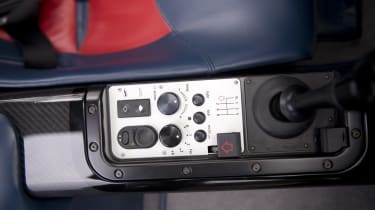The original McLaren F1 press release in full - Every detail of the incredible V12 supercar - McLaren F1 electronics
As McLaren re-publishes the full, original 1992 press release for its F1 supercar, it's a perfect time to celebrate the F1, we think
TECHNOLOGY IS EMPLOYED WHICH HAS BEEN STRICTLY CONFINED UNTIL NOW TO THE HIGHEST LEVELS OF FORMULA 1 AND SPORTS CAR RACING
Close collaboration between McLaren Cars and their sister company in the TAG/McLaren Group – TAG Electronic Systems – has provided the F1’s highly innovative and sophisticated engine and chassis control features.
TAG Electronic Systems offer a level of electronics expertise unparalleled within the motor industry, and is responsible for the electrical system on the F1. Throughout the F1, technology is employed which has been strictly confined until now to the highest levels of World Championship Formula 1 and sports car racing.
The Engine Management System – EMS – combines the technology TAG has applied in Formula 1 and Group C management systems with the stringent extra demands of road-going emission control. Its computing is approximately ten times that of a mass-market equivalent.
It provides individual ignition timing and fuelling control for every pulse on each cylinder and also manages the engine’s variable valve timing. Its software ‘algorithms’ which calculate ignition timings and fuel quantity consider such diverse factors as the rate of throttle movement and ambient atmospheric conditions. Split-second calculations are repeated on every firing cycle to ensure the most instantaneous information is acted upon.
Further software algorithms monitor conditions within th inlet manifolds, commanding precisely calculated mixture enrichment or leaning-out during rapid throttle variations to provide genuine Formula 1-style engine response.
The EMS employs feedback from four oxygen sensors to ensure the fuel/air ratio never exceeds the optimum working range of the exhaust-cleaning catalytic converters. Hence, even the world’s most stringent emissions requirements are complied with.
An additional EMS function is to monitor engine use, logging temperature extremes, peak revolutions reached, high loads when not properly warmed through and myriad other details of the V12’s operational life. This engine logging can then be accessed during normal servicing to identify cause and effect.
A second electronics unit, the Car Equipment Controller – CEC – manages everything from the electrically-heated cockpit glass to the brake cooling-duct flaps. Glass de-icing load can soar as high as 1,000 Watts, handled by a TAG-designed DC/DC converter. The CEC also monitors battery state and alternator charging and regulates glass heating load to suit.
Brake-cooling flap control is derived from road speed and brake-line pressure sensors. The aerodynamic BB ‘Foil is also CEC controlled, via cockpit command when high downforce mode is selected, although brake cooling demands automatically over-ride as required.
The CEC also supplies data to the instrument panel, manages the F1’s anti-theft system, checks all lamps, controls the courtesy lights and decides when to switch on the engine-bay cooling fans. It monitors all electrical system functions and checks safety conditions, for example braking the window lifts should they become obstructed. It also prevents the windows from being opened above 130mph (209km/h).
Both CEC and EMS systems constantly monitor both themselves and all functioning of the F1’s other electrical systems. If a fault should be detected, the CEC can signal the driver via the instrument panel display, indicating both the fault and its severity.
In servicing, both EMS and CEC can communicate with the standard BMW computerised service tester, but a second more unusual facility is also featured.
A modem telephone link is fitted in the car, permitting direct downloading of information to McLaren Cars. Diagnostic circuits within the EMS and CEC then identify faulty components and transmit the information direct for assistance.
It is unlikely, however, that this modem telephone link would be required other than to verify that all is well. TAG Electronics Systems’ EMS and CEC units for the F1 embody all the hard-won lessons of Formula 1 experience. They are built to the most exacting standards, and every unit undergoes extensive testing prior to installation in the F1.




